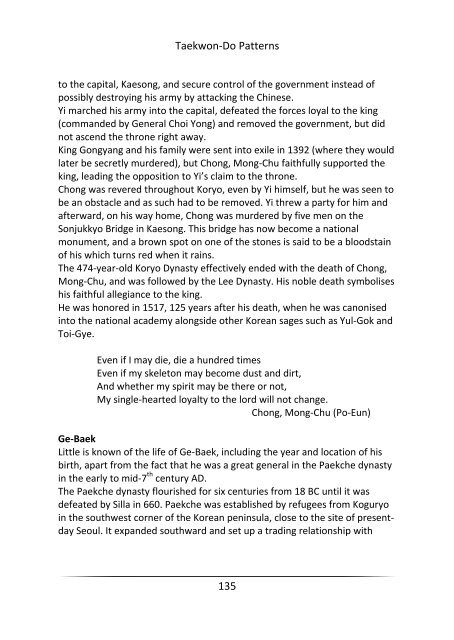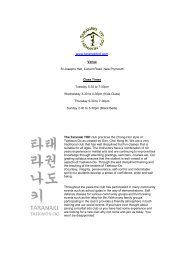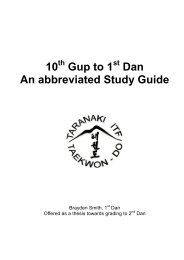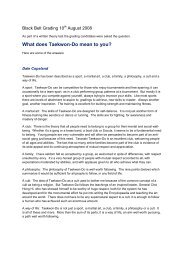Taekwon-Do Patterns (Tul) - Taranaki ITF Taekwondo
Taekwon-Do Patterns (Tul) - Taranaki ITF Taekwondo
Taekwon-Do Patterns (Tul) - Taranaki ITF Taekwondo
You also want an ePaper? Increase the reach of your titles
YUMPU automatically turns print PDFs into web optimized ePapers that Google loves.
<strong>Taekwon</strong>‐<strong>Do</strong> <strong>Patterns</strong><br />
to the capital, Kaesong, and secure control of the government instead of<br />
possibly destroying his army by attacking the Chinese.<br />
Yi marched his army into the capital, defeated the forces loyal to the king<br />
(commanded by General Choi Yong) and removed the government, but did<br />
not ascend the throne right away.<br />
King Gongyang and his family were sent into exile in 1392 (where they would<br />
later be secretly murdered), but Chong, Mong‐Chu faithfully supported the<br />
king, leading the opposition to Yi’s claim to the throne.<br />
Chong was revered throughout Koryo, even by Yi himself, but he was seen to<br />
be an obstacle and as such had to be removed. Yi threw a party for him and<br />
afterward, on his way home, Chong was murdered by five men on the<br />
Sonjukkyo Bridge in Kaesong. This bridge has now become a national<br />
monument, and a brown spot on one of the stones is said to be a bloodstain<br />
of his which turns red when it rains.<br />
The 474‐year‐old Koryo Dynasty effectively ended with the death of Chong,<br />
Mong‐Chu, and was followed by the Lee Dynasty. His noble death symbolises<br />
his faithful allegiance to the king.<br />
He was honored in 1517, 125 years after his death, when he was canonised<br />
into the national academy alongside other Korean sages such as Yul‐Gok and<br />
Toi‐Gye.<br />
Even if I may die, die a hundred times<br />
Even if my skeleton may become dust and dirt,<br />
And whether my spirit may be there or not,<br />
My single‐hearted loyalty to the lord will not change.<br />
Chong, Mong‐Chu (Po‐Eun)<br />
Ge‐Baek<br />
Little is known of the life of Ge‐Baek, including the year and location of his<br />
birth, apart from the fact that he was a great general in the Paekche dynasty<br />
in the early to mid‐7 th century AD.<br />
The Paekche dynasty flourished for six centuries from 18 BC until it was<br />
defeated by Silla in 660. Paekche was established by refugees from Koguryo<br />
in the southwest corner of the Korean peninsula, close to the site of present‐<br />
day Seoul. It expanded southward and set up a trading relationship with<br />
135

















